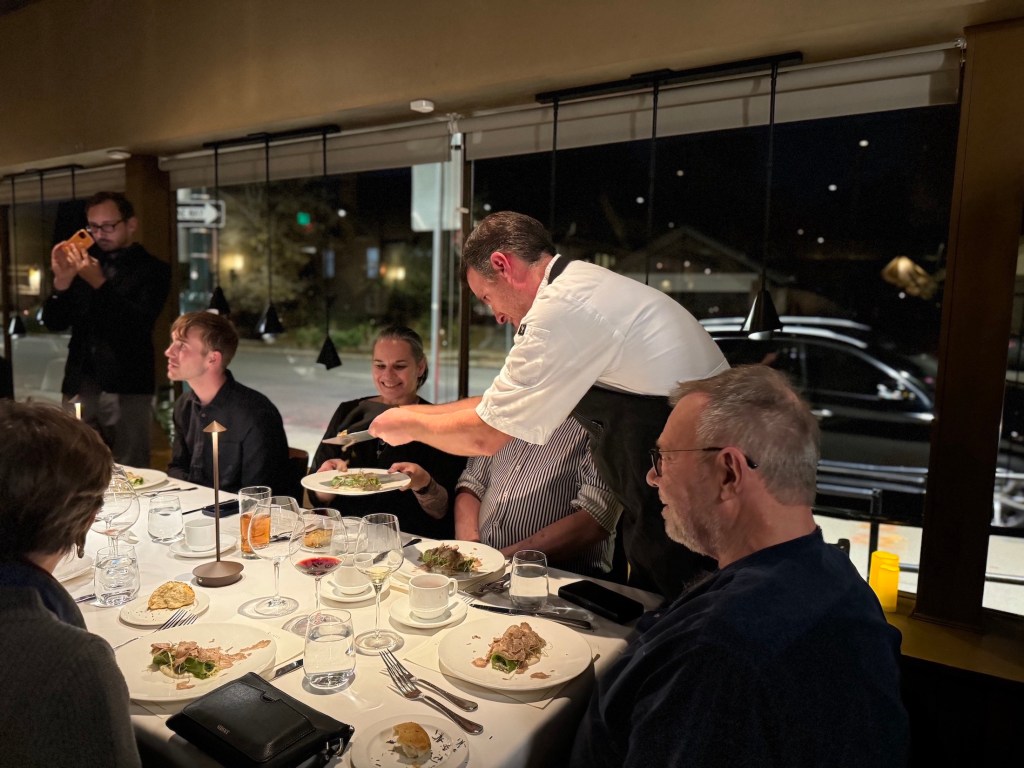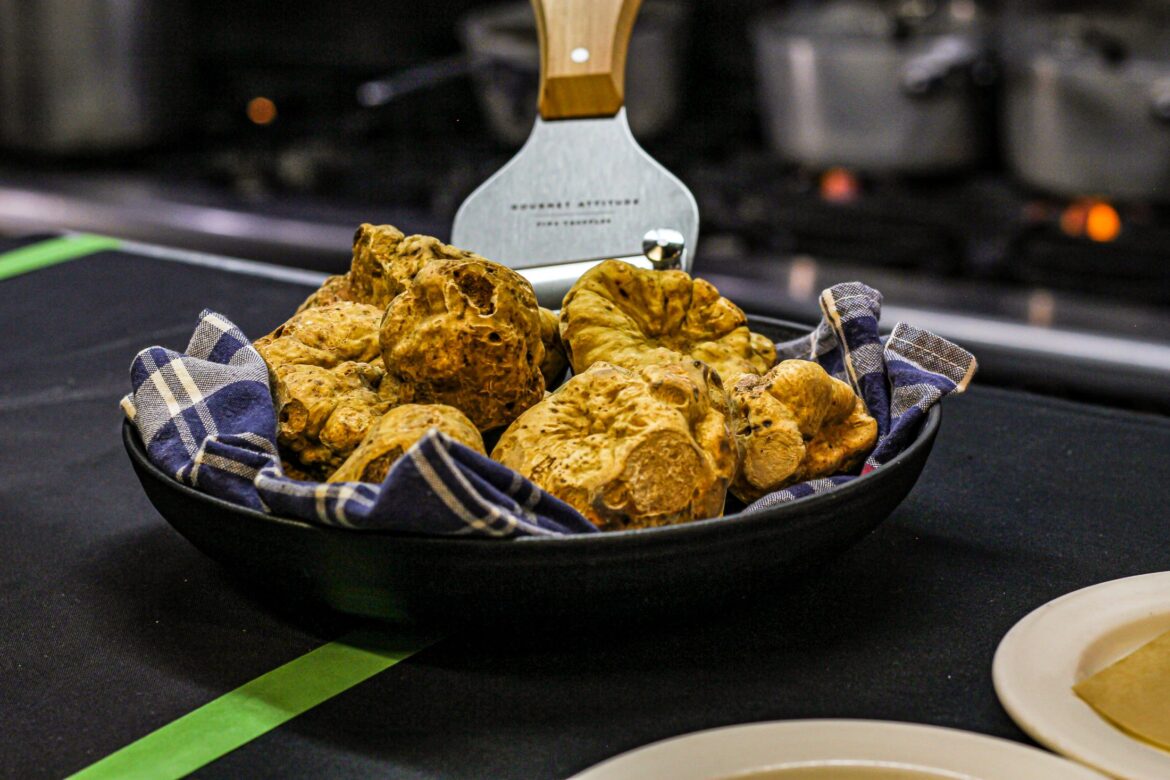Year-end expenses can add up quickly. There are ski passes to buy, holiday gifts to plan for — and this year is particularly tough for those facing food insecurity with the interruption of SNAP benefits (and for federal workers, paychecks), thanks to the ongoing government shutdown.
Ironically, it’s also the time of year that the most expensive ingredient to hit restaurant menus becomes available: the elusive white truffle. If that’s a luxury you can afford (after first contributing to meal assistance programs for the less fortunate), several Denver-area eateries have released the dates of their annual truffle dinners and à la carte truffle availability.
Truffles are a fairly common on menus throughout the year, typically taking the form of the less elusive (but still pricey) black truffle. But come fall, restaurants have the opportunity to get their hands on the far more rare (and even pricier) white truffle. And the difference between the two is, well, black and white.
The most obvious difference is the price. Black truffles are typically available for about $600 a pound. The same weight in white truffles runs closer to $4,000. (That’s a notable increase from the $2,500 reported in 2018.)
 During Barolo Grill’s Truffle Week, guests can opt to have 5 grams of truffle shaved on any dish for an additional $95.
During Barolo Grill’s Truffle Week, guests can opt to have 5 grams of truffle shaved on any dish for an additional $95.
Why are white truffles more expensive than black truffles?
For starters, they are completely different breeds — not just different colors of the same plant. Black truffles are far more resilient. They can be grown year-round in many locations, and are even cultivated in some instances. As a result, restaurants can procure black truffles from multiple purveyors. What’s more, their thick skin allows for a relatively longer shelf life.
White truffles are far more rare, growing only in their native region of Piedmont, Italy. They cannot be cultivated, so suppliers must rely on foragers who harvest them by hand in the wild. They’re also more delicate, requiring great care to store. And their short shelf life gives chefs only a few days to use them before re-upping for another batch.
 White truffles cannot be cultivated, requiring foraging by hand, such as this truffle hunter and his dog in Alba, Italy.
White truffles cannot be cultivated, requiring foraging by hand, such as this truffle hunter and his dog in Alba, Italy.
Austin Carson, co-owner, Restaurant Olivia
That last point is why Denver restaurants schedule very specific white truffle dinner dates, so they know exactly when their allotment of truffles will be used, and for how many people. At $4,000 a pound, waste is not an option.
“There’s a high limitation to procuring a white truffle, and they’re incredibly fragile,” says Barolo Grill owner Ryan Fletter, noting that staff must weigh the white truffles nightly, wrap them in napkins, and then store them in an airtight container, wearing special gloves the entire time. “For us, the pressure valve is quite high. It’s nail-biting to order them, get them shipped to us at the right time, preserve them, and execute them immediately, then get another shipment in.”
Between the price, the inconvenience and the risk, you might wonder why restaurants even bother. But then, of course, there’s the most important factor: the taste.
What do white truffles taste like?
Now, there’s nothing wrong with black truffles. They have a wonderfully nutty, rich and deep flavor not unlike mushrooms, but more elevated and earthy. White truffles are far more refined, with a softer and more delicate flavor that’s almost garlicky and cheese-like. And while lighter, their aromatic quality is five to ten times that of their black truffle counterparts.
As a result, you don’t really “cook” a truffle. The most common is simply shaving them over prepared dishes — the fattier the better.
 Restaurant Olivia’s tajarin pasta with shaved white truffles
Restaurant Olivia’s tajarin pasta with shaved white truffles
Austin Carson, co-owner, Restaurant Olivia
“Things with eggs, mushrooms, cheese for sure,” says Barolo Grill chef Darrel Truett. “Pastas are always great. Just butter and lots of fat and rich foods. They go really, really well with raw meat or beef. When I’m making a menu, I have to have vegetable dishes. So sunchokes and root vegetables like carrots and celery root. With seafood, they go super well with scallops.”
Taken together, the cost of white truffles combined with their application on rich and fatty foods and the short-term availability at the end of the year make white truffle dinners an appropriate kickoff to holiday season indulgence.
Where can you eat white truffles in Denver this fall?
“It’s an exciting time of year,” says Fletter. “It’s a celebratory thing, and also a ritual for us in the neighborhood and the community, because it’s part of Italian cuisine. If you were in Italy right now, any chef is showing off their white truffles and having a really good time with them. And so it’s a nice way to just connect everybody to that part of the world.”
Perhaps that’s why you’ll mostly find Italian restaurants hosting truffle dinners in the coming weeks. Barolo Grill has held an annual truffle dinner for over twenty years; the next one takes place on November 10. For $695 per seat, guests will enjoy an eight-course, truffle-forward dinner (including both black and white varieties) with wine pairings — tip included. While the full menu remains in flux, chef Truett hints at a truffle egg custard, raw veal crudo and lots of pasta.
Meanwhile, Boulder’s Michelin-starred Frasca is hosting what may be the most expensive meal of the year. Its white truffles and Barolo wine dinner on November 20 and 21 is priced at a whopping $1,598 for a seat. The event begins with a canapé reception and glasses of Krug Grand Cuvee Champagne. White truffles will be shaved tableside for every course served during the evening, and the food will be paired with a lineup of benchmark Nebbiolo.
Restaurant Olivia follows with a five-course, truffle-based tasting menu on November 22 at $350 a person, with an optional wine pairing; details on that menu are pending. Finally, Tavernetta Vail, a Frasca sibling, is getting in the game with a Truffle and Barolo dinner on December 11 for $999, featuring such dishes as a truffle egg and a fontina cheese raviolo with white truffle.
For those looking for a more “entry-level” way to enjoy white truffles this season, several restaurants offer the option of simply adding shaved white truffles to any dish. At Barolo, the add-on is $95 for five grams for the week starting November 10, dubbed Truffle Week, when the restaurant will also eature other off-menu truffle specials. Jovanina’s Broken Italian is also offering truffle shavings, at $120 per five grams.
“It’s the holidays,” says Fletter. “What is very expensive and alluring is also just a special thing. It’s not something you get every day.”


Dining and Cooking